Authored by Liankun Wang*,
Abstract
In this paper, the elastic buckling of cracked thin plates repaired by composite laminate patch under compression was studied by the finite element method. The effects of the shape of the repairing patch, size of the repairing patch, and the thickness of the patch on the elastic buckling load were evaluated. The results show that the size and thickness of the repairing patch must be optimized to increase the performance of the repairing.
Keywords:Thin plate; Finite element; Buckling analysis; Composite material
Introduction
Thin plates are one of the main structural forms in engineering. The buckling of the thin plate has attracted much attention in the past few decades. However, the crack problems usually arise when the thin plate is subjected to cyclic loadings, which will decrease the buckling load of the thin plate. Therefore, strengthening the cracked plate by a composite patch is an effective way to increase the buckling load.
Most of the previous studies have focused on the buckling analysis of the damaged plates or cracked plates. Lin Dongliang [1] studied the buckling performance of thin plates containing singlerow circular holes under unidirectional non-uniform compression. Several parameters on the buckling capacity of the perforated plates were studied. Hou Xianglin [2] employed the finite element method to analyze the buckling behaviors of the simply supported open-walled plates under axial compression. Brighenti [3-5] analyzed the buckling problem of cracked rectangular elastic sheets with different geometrical dimensions, boundary conditions, and bearing modes. Seifi and Khoda-yari [6] conducted experimental and numerical studies on the buckling of cracked plates under full compression and partial edge compression. The effects of crack location, plate thickness, and boundary conditions on the buckling load were studied. Miao Xuezhou [7] studied the repairing effects by the finite element method. Their results show that important design parameters that have a significant impact on the final failure load of the motherboard.
As a new structural repairing technique, composite patch bonding repair technology has its own advantages compared with traditional mechanical repairing technology and can improve the strength of the damaged plate. Therefore, predicting the buckling behavior of the repaired structures can improve the repair design of damaged structures. So, in this paper, the finite element method was used to analyze the buckling of the cracked thin plates. The parameters of the cracked plates such as the shape and size of the patch and the thickness of the rubber layer on the repairing effects were considered.
Geometric Model
The geometric dimensions and material parameters of the model in this study are the same as those in the study by Zhang [8] as shown in Figure 1. A steel plate contains a circular hole in the middle and two cracks on both sides of the circular hole. The detailed dimensions are included as follows: height H=120mm, width W=80mm, thickness t=3mm, hole radius R = 5mm, elastic modulus E=200000Mpa, Poisson’s ratio r=0.3.
The material properties of the patch are as follows: E1 =138000Mpa , E2 = 9700Mpa , E3 = 9700Mpa , G12 = 9700Mpa , G13 = 6900Mpa , G23 = 3200Mpa , ν12 = 0.28 , ν13 = 0.28, ν23 = 0.02 .
The binder is made of FM73 rubber, and its material properties are as follows: E = 2200Mpa , 37 Ps = Mpa .
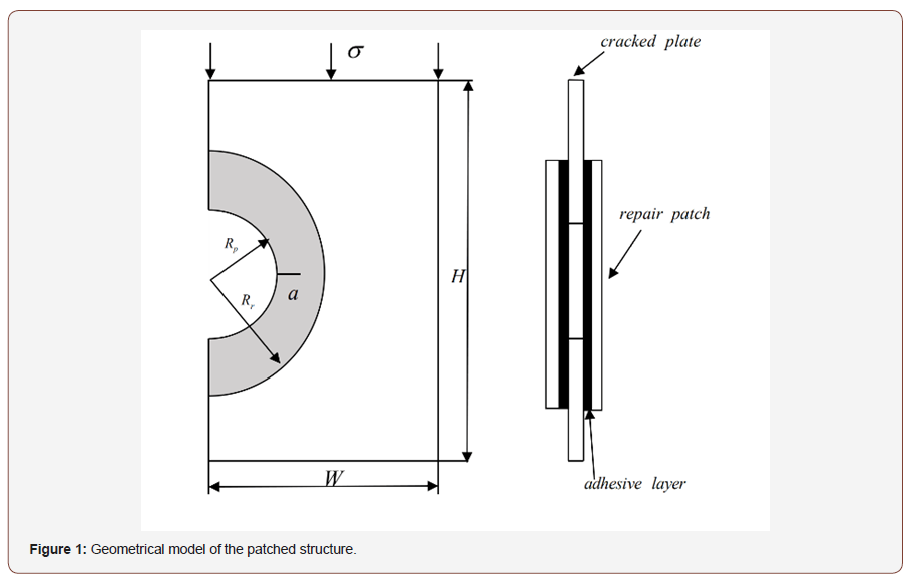
Finite Element Model
In this paper, ABAQUS was used to perform the eigenvalue buckling analysis of this structure. The finite element model consisted of three parts: the cracked plate, the glue layer, and the repairing patch. Due to symmetry, only half of the structure was created in the finite element study. The tie layer was used between the repairing patch and cracked plate. Figure 2 shows a typical mesh mode and boundary conditions for the entire structure.
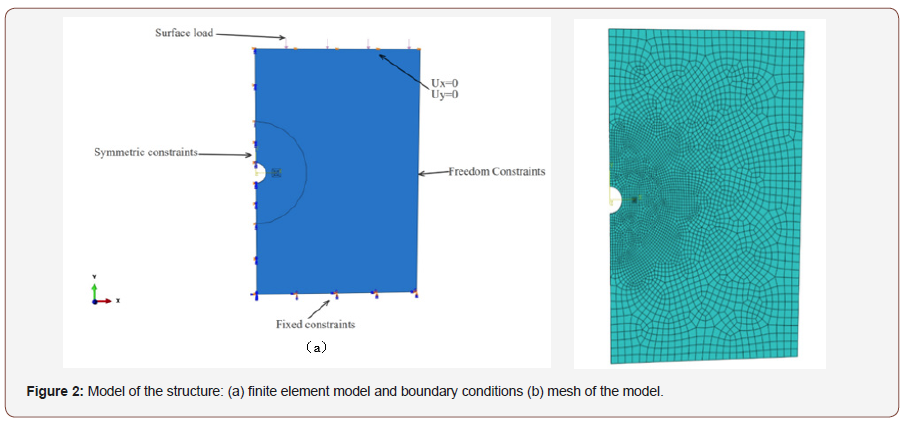
Results
Effect of the patch shape on the buckling load
Four kinds of repairing patch, including the circular patch, quadrilateral patch, and regular hexagon patch were selected in this paper to analyze and compare the repairing effects of different patches. Detailed descriptions of the patches are shown in Figure 3.
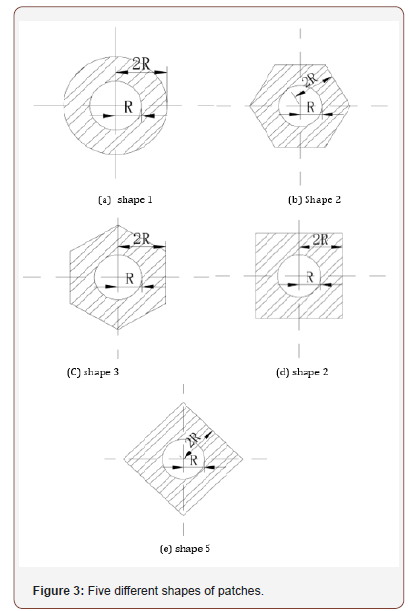
The thickness of the patch was fixed at 1 mm, and the thickness of the adhesive layer was 0.2 mm. In this paper, the buckling loads of the cracked plate with repairing and without repairing were both calculated. The results are shown in Figure 4. As we can see in Figure 4, the repairing patch can obviously improve the stability of the cracked plate. However, the shape of the patch has little effects on the improvement of the buckling loads. Comparing the first order buckling mode of the cracked plate without patch and with No. 4 patch, it is found that the first order buckling mode of the cracked plate is the same. However, compared with the unrepaired structure, the stiffness of the plate is improved, which can be seen from the first order buckling mode diagram (Figure 5). The lateral displacement of the motherboard is significantly suppressed. The first order buckling mode here consistent with the structural buckling deformation observed in the compression experiments in the literature [9].
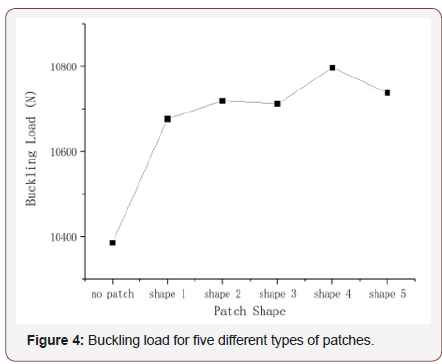
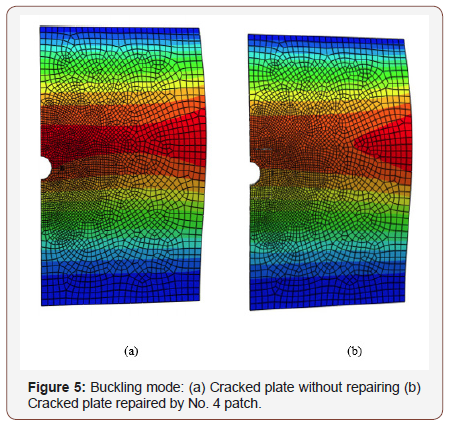
Effect of the patch radius on the buckling load
In order to study the size of the repairing patch on the buckling load, five radiuses (R, 2R, 2.5R, 3R, 3.5R, and 4R) of the circular patch are selected in this paper. Here, the buckling loads of the patched composite laminates of radius were calculated by keeping the thickness of the patch at 1mm and the thickness of the glue layer at 0.2mm. The results are shown in Figure 6.
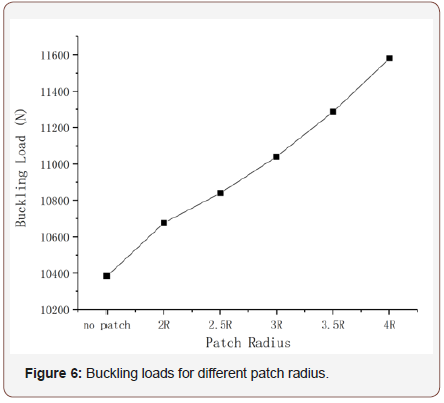
The results show that the buckling loads increase with the increase of the patch radius. We can also see that when the patch radius increases from 2R to 5R, the buckling load increases by 8% which indicates that the repairing effects can be improved by increasing the patch radius in the actual repair work.
Effect of the patch thickness on the buckling load
The circular patch was selected to study the effect of the patch thickness on the buckling load. In this study, the diameter of the patch was fixed at 3R, and the patch thickness varied from 0.6 mm to 2.2 mother results are shown in Figure 7.
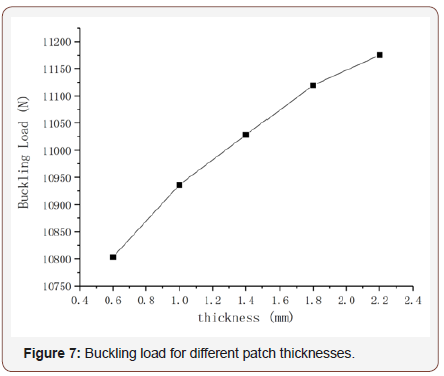
As can be seen from Figure 7, the buckling load of the plate increases with the increase of the patch thickness. When the patch thickness increased from 0.6 mm to 2.2 mm, the buckling load of the repaired structure increased by 3%.
Conclusion
• The finite element method was used to study the buckling behavior of the cracked plate repaired by composite patch under compression.
• Compared with other shapes of the repairing patch, the square patch has the most improvement in buckling load.
• The radius and the thickness of the repairing patch are the most important factors to improve the repairing effect and increase the buckling load of the cracked plate.
To read more about this article...Open access Journal of of Engineering Sciences
Please follow the URL to access more information about this article
To know more about our Journals...Iris Publishers





No comments:
Post a Comment